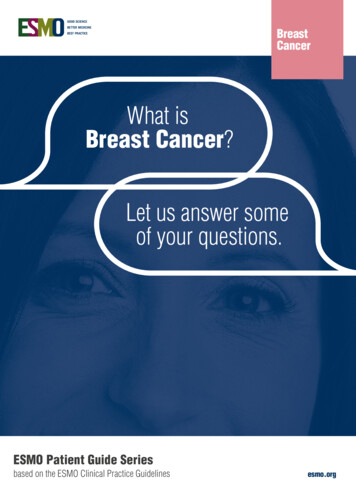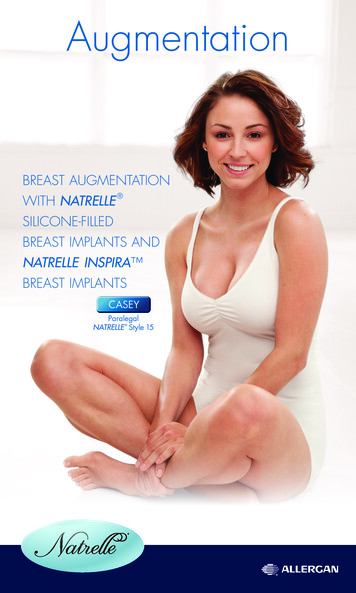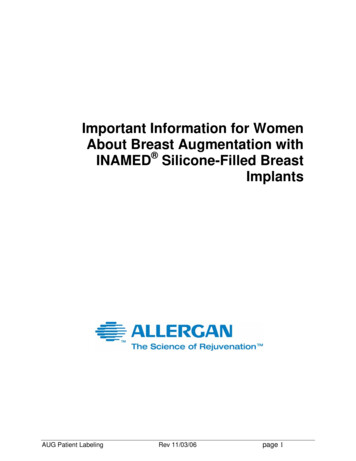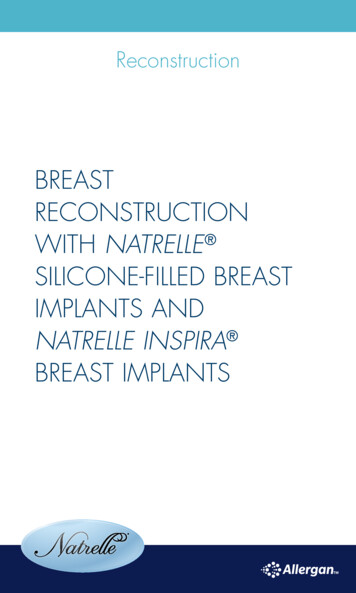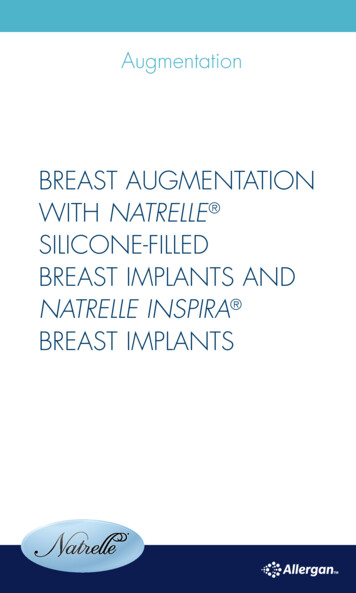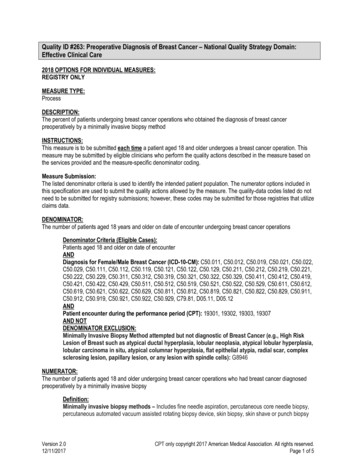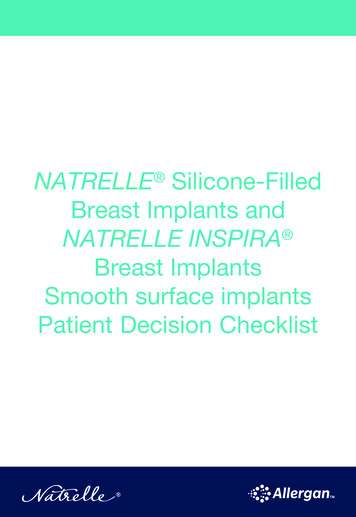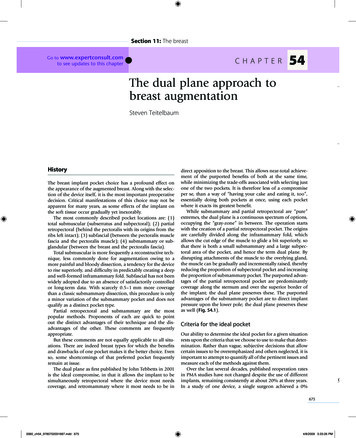
Transcription
Section 11: The breastGo towww.expertconsult.comCHAPTERto see updates to this chapter54The dual plane approach tobreast augmentationSteven TeitelbaumHistoryThe breast implant pocket choice has a profound effect onthe appearance of the augmented breast. Along with the selection of the device itself, it is the most important preoperativedecision. Critical manifestations of this choice may not beapparent for many years, as some effects of the implant onthe soft tissue occur gradually yet inexorably.The most commonly described pocket locations are: (1)total submuscular (subserratus and subpectoral); (2) partialretropectoral (behind the pectoralis with its origins from theribs left intact); (3) subfascial (between the pectoralis musclefascia and the pectoralis muscle); (4) submammary or subglandular (between the breast and the pectoralis fascia).Total submuscular is more frequently a reconstructive technique, less commonly done for augmentation owing to amore painful and bloody dissection, a tendency for the deviceto rise superiorly, and difficulty in predictably creating a deepand well-formed inframammary fold. Subfascial has not beenwidely adopted due to an absence of satisfactorily controlledor long-term data. With scarcely 0.5–1 mm more coveragethan a classic submammary dissection, this procedure is onlya minor variation of the submammary pocket and does notqualify as a distinct pocket type.Partial retropectoral and submammary are the mostpopular methods. Proponents of each are quick to pointout the distinct advantages of their technique and the disadvantages of the other. These comments are frequentlyappropriate.But these comments are not equally applicable to all situations. There are indeed breast types for which the benefitsand drawbacks of one pocket makes it the better choice. Evenso, some shortcomings of that preferred pocket frequentlyremain at issue.The dual plane as first published by John Tebbetts in 2001is the ideal compromise, in that it allows the implant to besimultaneously retropectoral where the device most needscoverage, and retromammary where it most needs to be indirect apposition to the breast. This allows near-total achievement of the purported benefits of both at the same time,while minimizing the trade-offs associated with selecting justone of the two pockets. It is therefore less of a compromiseper se, than a way of “having your cake and eating it, too”,essentially doing both pockets at once, using each pocketwhere it exacts its greatest benefit.While submammary and partial retropectoral are “pure”extremes, the dual plane is a continuous spectrum of options,occupying the “gray-zone” in between. The operation startswith the creation of a partial retropectoral pocket. The originsare carefully divided along the inframammary fold, whichallows the cut edge of the muscle to glide a bit superiorly, sothat there is both a small submammary and a large subpectoral area of the pocket, and hence the term dual plane. Bydisrupting attachments of the muscle to the overlying gland,the muscle can be gradually and incrementally raised, therebyreducing the proportion of subpectoral pocket and increasingthe proportion of submammary pocket. The purported advantages of the partial retropectoral pocket are predominantlycoverage along the sternum and over the superior border ofthe implant; the dual plane preserves these. The purportedadvantages of the submammary pocket are to direct implantpressure upon the lower pole; the dual plane preserves theseas well (Fig. 54.1).Criteria for the ideal pocketOur ability to determine the ideal pocket for a given situationrests upon the criteria that we choose to use to make that determination. Rather than vague, subjective decisions that allowcertain issues to be overemphasized and others neglected, it isimportant to attempt to quantify all of the pertinent issues andmeasure each of the methods against them.Over the last several decades, published reoperation ratesin PMA studies have not changed despite the use of differentimplants, remaining consistently at about 20% at three years.In a study of one device, a single surgeon achieved a 0%G6750060 ch54 9780702031687.indd 6754/8/2009 3:33:26 PM
Section 11: The breastABComplete division along IMFNo divisionNo divisionNo divisionAesthetic Plastic SurgeryCFig. 54.1 The three types of dual plane breast augmentation. A, Dual Plane Type I. B, Dual Plane Type II. C Dual Plane type III.Fig. 54.2 Retromuscular pockets are often criticized for causing high-ridingimplants. In this case, the dissection was a blunt/blind transaxillaryaugmentation. The muscle was divided along the IMF on the left, but not theright. This is not a shortcoming of the procedure itself, but from its executionin this particular instance.3-year reoperation rate in contrast to an average of 13.9% forall the doctors in the study. Taken together, these two findingsdemonstrate that the outcome in breast augmentation isdetermined far less by the type of the device than by otherfactors (Fig. 54.2).In the absence of data, surgeons must turn to the anecdotal. But when data is available, it trumps anecdote. Of allendpoints, the most decisive measurement of outcome is thereoperation rate, as it is an incontrovertible endpoint. “Satisfied” or “happy” patients are imprecise and unquantifiableendpoints, and since we have all seen unhappy patients withbeautiful results and thrilled patients despite notable problems, they do not qualify as adequate endpoints with whichto entirely judge the quality of an operation.The absolute incidence of reoperation tells only part of thestory: the severity of a problem must also be considered.Some may be minor or annoying, while others may beGdeforming and even uncorrectable. It is therefore not enoughjust to tally complications, but also to consider theirseverity.Dual plane data objectively show that this procedure succeeds in maintaining the advantages of both pockets whilemitigating the trade-offs associated with selecting a singlepocket.Preservation of future options in the event of an unsatisfactory outcome is important: if Plan A was still a viable optionafter Plan B, but Plan B would not be after Plan A, then thatwould suggest an advantage for starting with Plan B.Finally, outcomes need to be assessed at long intervals aftersurgery. Irrevocable, permanent, progressive, and at timestotally uncorrectable changes occur to a breast years after anaugmentation. Adequacy of tissue coverage needs to be judgedat the longest possible intervals, decades if possible. Suchlong-term data is meager, but owing to the importance ofsuch lifelong changes on the breast, at this point anecdoteand extrapolation of shorter-term results should be considered (Fig. 54.3; Table 54.1).Pain and recoveryIn general, there is less pain with the submammary approach,as the submuscular approach subjects the sensitive rib cageto possible trauma and the overlying muscle to stretching. Butthe largest data ever assembled on postoperative pain showedthat 24-hour recovery without the use of any narcotics orpain pumps could be routinely achieved with a dual planeapproach. Bloodless surgery and avoidance of creating any ribtrauma circumvented the typical pain experienced from therib cage in submuscular patients. Precise, gentle elevation,bloodless elevation of a pectoralis muscle paralyzed by theanesthesiologist results in a minimum of trauma to themuscle.This author has routinely been using these techniques formany years, and only uses ibuprofen for postoperative painfor routine augmentation mammaplasty in all planes, including the dual plane. Dual plane patients routinely go out todinner, shower, and wash and brush their own hair the nightof surgery. They describe the feeling as “tight”, a “pressure”,“soreness”, or “like working out hard”.6760060 ch54 9780702031687.indd 6764/8/2009 3:33:26 PM
Chapter 54 The dual plane approach to breast augmentationABCDFig. 54.3 A&C, Preoperative. B&D, Postoperative. Anecdotes are anecdotal, but sometimes that is the best that we have. If anyone doubts the importance ofmuscle coverage, they should be shown a series of patients with tissue so thin, with a saline implant looking like this, 11 years after surgery, free from capsularcontracture, visible edges or rippling. Cases like this abound, but there are few examples of submammary or subfascial patients at this interval that look thisgood.When these same techniques are applied to the submammary approach, patients typically feel slightly less stiff andsore than do dual plane patients, but both groups still consistently achieve a “24-hour” recovery. Any difference issubtle, noted only for a day or two, and is of no real consequence, particularly relative to advantages of achieving moremuscle coverage.Coverage and stretchSoft tissue coverage is the single-most important issue affecting the short and long-term result after a breast augmentation. With adequate coverage, the implant edges are lessvisible, and the breast looks more natural and less augmented.Any folds or irregularities with the implant shell are moreconcealed. With more tissue over it, the device is less palpable. With less tissue coverage, the edges of the implant aremore visible, the breast looks more augmented, and it iseasier to feel the implant (Fig. 54.4).Over the long term, these changes become more profound.Implants put pressure on the breast, and the parenchymagradually compresses and atrophies. The presence of theimplant stretches and thins skin. This occurs with implantsin all positions. No study will ever randomize patients ofsimilar tissue types and implant sizes and follow them overenough time for a scientific conclusion to be made. But a largeamount of clinical observation and logic (see Fig. 54.3 andFig. 54.5) offers us guidance.Examples of submammary patients with severe parenchymal atrophy abound, while retropectoral patients with similarcharacteristics are rarely seen. And when they are, though theimplants may have ostensibly been placed “behind themuscle”, secondary surgery frequently reveals that the musclehas been avulsed off both the inframammary fold andsternum, thereby sacrificing the critical coverage of which weare speaking (Fig. 54.6).These problems are sometimes noticeable within a year ortwo, but can often take years more to develop. We must beG6770060 ch54 9780702031687.indd 6774/8/2009 3:33:28 PM
Section 11: The breastAesthetic Plastic SurgeryTable 54.1 Pocket comparisonsIssueAdvantagePRPLess painBetter coverageAdvantagesubglandularDual plane remediesXBest data to dateXLarge advantage vs. SM; difference relative to PRPdependent upon release and up to determination ofsurgeonAccess to lower pole parenchymaXYesExpands constricted breastsXYesFills ptotic breastsXYesAvoids muscle animationXRarely clinically significantReduces tendency to “ride high”XYesReduces tendency to “lateralize”XYesFaster recoveryXBest data to dateLess capsular contractureXBest data to dateBetter for mammogramsXAppears to beReduce parenchymal atrophyXBest data to dateReduces stretch deformitiesNarrower cleavageGBest data to dateXNo – but subglandular can only do so at the expense ofcoverageFig. 54.4 Tissue coverage is always a priority, particularly superiorly andmedially. The implant she holds in her hand mimics what is occurring withinher breast. With muscle coverage in the upper pole, such a deformity willrarely if ever occur.Fig. 54.5 This is not a capsular contracture. This is a submammary implant.The breast is soft. The patient chose this at the surgeon’s behest in order toavoid animation deformity. But even in repose, the significant deformity ispresent; there is no substitute for soft tissue coverage.aware of these problems and remind ourselves that we needto create a result that will look good not just for years, butfor decades. As someone who sees many secondary problems,I can state categorically that subglandular patients presentmore frequently, with more severe problems, and with moreunsolvable problems than do subpectoral or dual planepatients.Such tissue thinning with submammary patients also is aset up for a problem which is difficult to correct, as to do sooften requires a switch to the partial retropectoral or dualplane position. But once there is a subglandular pocket, thecoverage in the retropectoral pocket is forever impaired.Though one can use sutures to tack the muscle back up to thegland, its caudal cut edge can never be retained as caudallyas it might have been were this not to have happened, therebyforever impairing inferior coverage. Marionette pulloutsutures have been described to hold down the muscle in thissituation, but this also cannot achieve the same degree of6780060 ch54 9780702031687.indd 6784/8/2009 3:33:31 PM
Chapter 54 The dual plane approach to breast augmentationcoverage as if the attachments between the muscle and theoverlying gland were never disrupted (Fig. 54.7).In conjunction with the thinning, there is often progressivestretch of the skin envelope, sometimes necessitating mastopexy. Even if this mastopexy would have been inevitable inthe future with a partial retropectoral or dual plane pocket,such patients frequently have soft tissue thinning or capsularcontractures in addition to the stretched skin. This necessitates a pocket change and possible capsulectomy in additionto the mastopexy, which can be a riskier procedure than if theimplant had started out dual plane or partial retropectoral.This combination of secondary revision occurs so frequentlythat efforts must be made at the time of the original surgeryso that this doesn’t happen (Fig. 54.8; also see Fig. 54.5).If tissue coverage is adequate, it almost doesn’t matter whatis going on with the implant; a capsular contracture may beless noticeable; suboptimal implant shape may be less problematic; implant folds might be harder to discern. These arepowerful reasons to select the partial retropectoral pocketover the submammary pocket.But what should one do if there is glandular ptosis or aconstricted lower pole and the tissue is thin? Partial retropectoral is preferred for the tissue coverage issue, but submammary may be necessary to allow better expansion of the lowerpole. The dual plane solves this dilemma by allowing theupper and inner portion of the implant to be covered bymuscle, while the inferior portion, the part that needs to pushdirectly on the gland to expand and fill it, can be allowed tobe in direct apposition.Achieving “adequate” coverage is an insufficient goal.“Maximum” coverage must be the goal. There is almost nolong-term problem that is not solvable when substantial softtissue is available, and there are few problems completelycorrectable when soft tissue is not available.There is some sacrifice in coverage with the dualplane relative to partial retropectoral, and if tissue coveragein the lower pole is such that the benefits of changing to thedual plane do not outweigh its advantages, then it is suggested to patients to have a partial retropectoral pocket.In any case, the reduction in coverage with the dualFig. 54.6 This patient just had removal of subpectoral implants. Thedotted line indicates the caudal border of the pectoralis. Though she had“retromuscular” pockets, the implant itself had negligible if any coverage asthe muscle was so high it could cover only a bit of the implant, and thepressure of it probably pushed the implant away. Though her muscle was stillattached to the sternum, the muscle had been inadvertently detached fromthe overlying parenchyma, thereby allowing it to window shade up far higherthan would be ideal even for a DP III.Fig. 54.7 This patient had a submammary capsulectomy and then had asubmuscular pocket dissected. It illustrates the basic principle of the DPapproach. With no attachment of the muscle to the overlying parenchyma,this muscle window shades strongly superiorly. The DP approach recognizesthe importance of maintaining those attachments when it is important tokeep the muscle inferiorly to maintain coverage, and emphasizes theimportance of a gradual and incremental release of them to allow controlledvertical elevation of the muscle and exposure of the parenchyma in the lowerbreast when the situation demands.ABGFig. 54.8 The most common argument for submammary placement is to deal with the postpartum involution and ptosis patient who does not wantmastopexy scars. But this group has the thinnest tissue and is the most prone to stretch and thinning. A, A patient merely two years following such aprocedure; note the extreme parenchymal atrophy and skin thinning. B, Note the improvement still noted two years after conversion to a dual plane.6790060 ch54 9780702031687.indd 6794/8/2009 3:33:33 PM
Section 11: The breastAesthetic Plastic Surgeryplane relative to partial retropectoral is reasoned andcontrolled.approach. The coverage that is preserved superiorly and medially typically allows for muscle coverage where it is mostneeded: superiorly and along the medial sternal border.Access to parenchymaThe most profound advantage of submammary over partialretropectoral is attributable to the direct pressure the implantcan make against the gland. This can make it look less empty,and the pressure can better expand a tight lower pole. Ifbehind the muscle, the muscle essentially protects the preexisting configuration of the lower pole, inhibiting theimplant’s ability to push it and fill it out. And if weak fibrousconnections between the pectoralis muscle and breast glandallow the gland to slipe relative to the muscle, placing theimplant against the breast tissue can help reduce the extentof inferior tissue migration. Otherwise, the subpectoral placement still allows the gland to slide inferiorly relative to themuscle (Figs 54.9 and 54.10).Depending upon the degree of release with the dual plane,these advantages of the submammary approach can be almostcompletely if not completely realized with the dual planepre2 yrsGCapsular contractureCapsular contracture still remains the leading cause of reoperation in PMA studies, yet publications using antibiotic irrigation and the dual plane pocket have resulted in some ofthe lowest reported capsular contracture rates to date. Whetherit is specifically due to the dual plane per se or other factors,such as the irrigation, is not entirely clear. But it is sufficientto say that the lowest reported capsular contracture rates arewith the dual plane position, and no paper suggests an advantage to partial retropectoral over dual plane. Dual plane is theideal choice.MammographyGiven the cancer prone nature of the breast, optimizing theability to detect cancer early must remain a priority. Numer-5 months3 yrs1 yr5 yrsFig. 54.9 The long term stability of the outcome in this post partum atrophy/ptosis patient with implants in the dual plane position demonstrates the value ofproper implant sizing and tissue coverage.6800060 ch54 9780702031687.indd 6804/8/2009 3:33:37 PM
Chapter 54 The dual plane approach to breast augmentationFig. 54.10 The constricted lower pole breast is frequently touted as being a reason for submammary, as it allows scoring of the lower pole. In this case, shownhere at 5 years post-surgery, a DP II was done, allowing the muscle to rise to the lower border of the areola. This exposed parenchyma for the entire lower poleof the breast, allowing it to be shaped just as much as it would have been were this to have been a submammary placement, but with maintenance of musclecoverage superiorly and medially, which helps to obscure the borders of the implant.ous authors have suggested an advantage to retropectoral oversubmammary placement for this regard, but it is unclearwhether the advantage is directly due to the anatomic location relative the muscle itself, or due to a lower capsularcontracture rate below the muscle. Suffice to say, mammogram is impaired when the breast tissue cannot be pulled outand away from the implant and placed between the mammogram plates, such as when the implant is hard, there is alarge implant relative to the breast tissue, or any other reasonthat restricts the pull of the tissue forward. While no studieshave specifically compared sensitivity of mammogrambetween these pockets over a long period of time, the lowincidence of capsular contractures and the extensive muscularcoverage over a dual plane implant suggests that this wouldnot be a problem. In any case, the role of MRI in screeningfor breast cancer is increasing, even for women without breastimplants. And since implants do not affect its sensitivity, thisentire issue may soon be moot.Muscle animationThe lack of significant implant motion or distortion withcontraction of the pectoralis is a significant advantage of thesubmammary position relative to the partial retropectoralpocket. But it is not enough to look at the problematic subpectoral patients with animation problems: one must alsobe aware of the submammary patients with significantimplant visibility even in repose. The deformity of a thinpatient with subglandular implants at rest is typically moreprofound than a partial retropectoral patient during maximalcontracture.With the dual plane approach, the release of the pectoralisalong the inframammary fold (IMF) reduces if not totallyeliminates the forces that might distract the implant superiorly. While the medial origins along the sternum may compress and slightly lateralize the implant on strong contraction,they rarely cause a significant deformity (Fig. 54.11).G6810060 ch54 9780702031687.indd 6814/8/2009 3:33:39 PM
Section 11: The breastNo divisionAesthetic Plastic SurgeryComplete division along IMFFig. 54.11 A critical step of all dual planes – I, II, and III – is to completelydivide the pectoralis major along the inframmary fold, stopping at thesternum, without division along the sternum. Failure to divide the originsalong the IMF result in either a high-riding implant, superior malposition withanimation, or a blunted IMF. However, if tissue coverage is thin ( 5 mm), theyprobably should not be divided, as maintaining coverage is the first priority.Division along the sternum can result in symmastia, excessive edge visibilityand uncorrectable deformities.Certainly, there is some motion, but in the Tebbetts series,there was no revision requested for this reason. In my experience, there has been occasional complaint and discussion ofrevision, but I have not switched my own patient to a submammary pocket for this reason (Fig. 54.12).Usually, the patients with any such problems are verythin, and were therefore the least well suited for a submammary pocket. The key in minimizing animation with the dualplane pocket is to uniformly and accurately take the muscledown along the inframammary fold, stopping evenly on bothsides at the point at which the IMF meets the sternum, andnever releasing along the sternum. It appears that when theIMF is horizontal and meets the sternum at a discrete point,these issues are less problematic than when the IMF curvessharply superiorly as it moves towards the sternum, oftentimes not actually meeting the sternum until being at or evenabove the level of the nipple. These patients are also oftenthin, and they represent a particular challenge, in that therein fact may be no way to avoid some deformity with eitherapproach.Fig. 54.12 DP and all retromuscular pockets are criticized for animation deformities. But the patient needs to be considered in repose as well. Here the samepatient on the top is seen submammary, relaxed in two different poses. Though there is no animation deformity, the implants are unattractive. In the lower left,she is shown relaxed in the DP position, looking much prettier and more natural. In the lower right, she does demonstrate distortion with contracture, but nodoubt even if this is the maximal distortion she can manage, it is still less deformed than she looks in either of the preoperative views in repose.G6820060 ch54 9780702031687.indd 6824/8/2009 3:33:44 PM
Chapter 54 The dual plane approach to breast augmentationNo matter which pocket is selected, the patient must befully informed preoperatively of the trade-offs, and participate in the pocket selection. That way, if she has an animationdeformity or implant deformity later, she can be remindedthat she preferred accepting that problem to the risks of theother pocket. If a patient is not made aware of these choicespreoperatively, then dissatisfaction and request for revisionremain avoidable risks for revision.Determination of need for coverage and formuscle releaseNarrower cleavageIt is always a goal to maintain as much coverage as possible,sacrificing coverage only when there is a reason to do so. Withthe exception of patient request (after being fully informed),a dual-plane approach is suggested to all. If coverage is 2 cmof pinch at the upper pole, then a submammary approachwill not even be offered. If pinch 5 mm at the IMF, seriousconsideration is given to not releasing the muscle to createthe dual plane, choosing instead to use a partial retropectoralpocket. In such situations, the long-term benefits of preserving maximal coverage often outweigh animation deformities,widening of the intermammary distance, and the predictability and crispness of the inframammary fold position.Both partial retropectoral and dual plane procedures acceptthe inner border of the pectoralis major muscle as an absolutelimit to the medial placement of the implants. Once submammary, the implant can certainly be more medial.However, this comes at a price: the patients who most requestor “need” such medialization invariably have the least softtissue cover, and moving the implant medial to where theinternal border of the pectoralis origin on the sternum resultsin risking symmastia and excessively visible implant edges. Itis foolhardy to attempt to create cleavage by excessive medialplacement of any implant, as tight skin usually pushes theimplant laterally and the thin skin results in distinctly visibleedges. So while the submammary does have the potential toplace implants more medially, this amounts to more of aliability than an advantage.Physical evaluationUntil experienced, most surgeons believe that an operation isall about what happens the day of surgery. In fact, it is the decisions that lead up to surgery that often have the most long-termeffects on a result. This is particularly true of breast augmentation, where patient wishes, patient anatomy, and surgeonjudgment converge. This topic is more important than pocketchoice or any other issue with breast augmentation alone. Thefollowing are the most important of these points:Patient educationThe patient must be informed about the limitations of hertissue, so that her expectations are met. She must anticipateall trade-offs with respect to issues such as tissue coverage,animation, correction of ptosis, etc. When patients participatein these choices and sign off on them, the incidence of revision surgery is reduced and patient satisfaction increases.Determination of ideal implant sizeA patient is asked to decide whether she wants an implantthat fits properly within her tissue, or she wants to force acertain size into her breasts without regard for creating anunnatural result in the short term and causing permanenttissue changes in the long term. Informed patients will usuallyselect the latter. In that case, using the base width, skin stretch,and degree of envelope fill, the ideal implant size for thatpatient’s breast is determined. Larger will have an upper convexity and look more full, stuffed, or fake. Smaller will havea concave upper pole and look emptier.The dual plane preserves coverage and allowing coveragewhere it is needed. These two opposing characteristics needto be evaluated in all patients.CoverageMuscle releaseThe breast is examined for lower pole constriction or glandular ptosis that might necessitate controlled release of themuscle from the gland. While one might decide specificallypreoperatively to perform a dual plane type II or type III, thesurgeon should always start by dissection a type I, and thenexamine and feel the breast, releasing as much as is necessaryduring the operation.Need for mastopexyMany patients see plastic surgeons for a breast augmentationfollowing lactation or weight loss. For some of these women,mastopexy is the appropriate procedure. Not wanting scars,some of these patients either receive an implant that fills, butis larger than they wish, or an implant of the size they wantbut which creates inadequate fill. In either case, and in particular in the case of the larger implants, the result is aesthetically compromised, and the already stretched skin stretchesmore and deteriorates with time. I have seen many suchpatients who had received submammary augmentations, andhave tried this on my own patients. If followed long enough,the results are frequently unsatisfactory. Neither is the dualplan an answer for these patients; if the nipple (N) is belowthe fold, if N : IMF distance is 9.5 cm on maximum stretch,or if substantial parenchyma lays caudal to the inframammary fold, mastopexy must be considered, and augmentationshould either not be attempted or only performed on thepatient who clearly demonstrates an understanding of thelimitations of such a procedure (see Fig. 54.8).AnatomyThe pectoralis major muscle has origins along the clavicle,sternum, and the 4th–6th ribs along the IMF, and inserts ontothe humerus, causing flexion and internal rotation. StudiesG6830060 ch54 9780702031687.indd 6834/8/2009 3:33:48 PM
Section 11: The breastAesthetic Plastic Surgeryhave demonstrated that the pectoralis origins along the IMFcan be released without loss of strength or coordination.What is most relevant to the dual plane is the recognitionthat the deep surface of the pectoralis glides over the chestwall. It is anchored like a trampoline on three sides to thehumerus, clavicle, and ribs. L
Go to www.expertconsult.com to see updates to this chapter 00060_ch54_9780702031687.indd 675060_ch54_9780702031687.indd 675 44/8/2009 3:33:26 PM/8/2009 3:33:26 PM. G Section 11: The breast Aesthetic Plastic Surgery 676 deforming and even uncorrectable. It is therefore not enough


